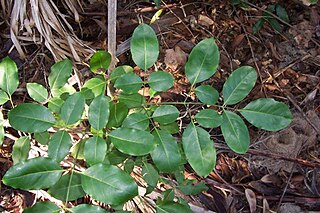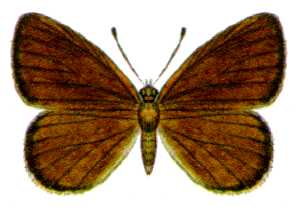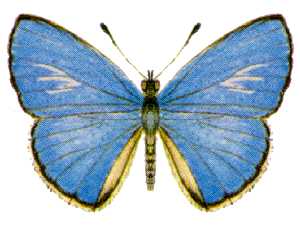
Candalides is a large genus of butterflies in the family Lycaenidae. The species of this genus are found in the Australasian realm.

Philiris is a genus of butterflies in the family Lycaenidae. The species of this genus are found in the Australasian realm, mostly inhabiting tropical rainforests. Philiris was erected by Julius Röber in 1891. It is a speciose genus. Tite decided on 56 species. Sands added 11 species and placed the taxa into 21 species groups. Most species are on New Guinea. Tite considered Philiris and Candalides Hübner, 1819 to be sisters. Eliot (1973) placed Philiris in Luciini Waterhouse & Lyell, 1914, close to Hypochrysops C. et R. Felder, 1860. Compared to other members of the tribe, Philiris have relatively uniform ventral patterns with usually silvery-white ground color.

Polyscias elegans, known as the celery wood, is a rainforest tree of eastern Australia. It occurs in a variety of different rainforest types, from fertile basaltic soils, to sand dunes and less fertile sedimentary soils. The range of natural distribution is from Jervis Bay in southern New South Wales to Thursday Island, north of the Australian continent. Other common names include black pencil cedar and silver basswood. Polyscias elegans is useful to bush regenerators as a nursery tree, which provides shade for longer-lived young trees underneath. Polyscias elegans is also known as Celery wood, Mowbulan whitewood, Silver basswood and White sycamore.

Polyscias murrayi, known as the pencil cedar, is a very common rainforest tree of eastern Australia.

Candalides absimilis, the pencilled blue or common pencil-blue, is a species of butterfly of the family Lycaenidae. It is found along the east coast of Australia, including Queensland, the Australian Capital Territory, New South Wales and Victoria.

Candalides acasta, the blotched blue, is a species of butterfly of the family Lycaenidae. It is found in southern Australia, including Queensland, New South Wales, Victoria, Tasmania, South Australia and Western Australia.

Candalides xanthospilos, the yellow-spot blue, is a species of butterfly of the family Lycaenidae. It is found in along the eastern coast of Australia, including Queensland, New South Wales and Victoria.

Candalides heathi, the rayed blue, is a species of butterfly of the family Lycaenidae. It is found in southern Australia, including South Australia, New South Wales and Victoria.

Candalides hyacinthina, the varied dusky-blue, is a species of butterfly of the family Lycaenidae. It is found along the east coast of Australia, including South Australia, New South Wales, Western Australia and Victoria.

Candalides cyprotus, the cyprotus blue or copper pencil-blue, is a species of butterfly of the family Lycaenidae. It is found along the east coast of Australia, including South Australia, New South Wales, Western Australia and Victoria.

Candalides erinus, the small dusky-blue, is a species of butterfly of the family Lycaenidae. It is found in Australia and Indonesia.

Candalides helenita, the shining pencil-blue, is a species of butterfly of the family Lycaenidae. It is found in Australia and Indonesia.

Candalides gilberti, the northern pencil-blue, is a species of butterfly of the family Lycaenidae. It is found in Australia in the Northern Territory and the north of Western Australia.

Tethea consimilis is a species of moth of the family Drepanidae first described by Warren in 1912. It is found in Asia, including the Russian Far East, Japan, Korea, Taiwan, Myanmar, Indonesia and India. The habitat consists of various types of mixed and broad-leaved forests.
Candalides geminus, the Geminus blue, is a species of butterfly of the family Lycaenidae. It was described by Edwards and Kerr in 1978. It is found in Australia.

Harpullia hillii, commonly known as blunt-leaved tulip or oblong-leaved tulip, is a tree in the family Sapindaceae, endemic to eastern Australia. It occurs in dry rainforest from the Burdekin River in Queensland southwards to Wauchope, New South Wales.
Cryptoptila australana, commonly known as the elderberry panax leaf roller, is a species of moth of the family Tortricidae. It is found in Australia, where it has been recorded from Queensland, New South Wales, the Australian Capital Territory and Victoria.
Epiphyas caryotis is a species of moth of the family Tortricidae. It is found in Australia, where it has been recorded from Victoria, the Australian Capital Territory and Tasmania. The habitat consists of montane rainforests and wet eucalypt forests.














